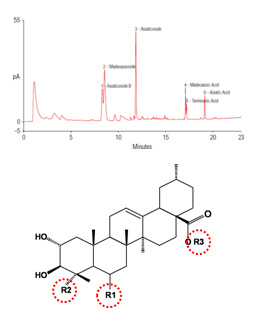Cosmetic Materials Business Unit
Thank your for visiting the Medicostech website.
Home
 Business Unit&Product Information
Business Unit&Product Information Cosmetic Materials Business Unit
Cosmetic Materials Business Unit Centella Asiatica
Centella Asiatica
 Business Unit&Product Information
Business Unit&Product Information Cosmetic Materials Business Unit
Cosmetic Materials Business Unit Centella Asiatica
Centella AsiaticaWhat is centella asiatica?
Centella asiaticia is a plant that is endogenous to Madagascar island, Africa.It is also called 'tiger grass' because a tiger would roll around the stack of grass when it is injured.
In Korea, centella asiatica, widely used in anti-wrinkle cosmetic products, is also called 'disease grass' for curing disease and has been known to not only treat skin disease but also stimulate collagen synthesis. Since its first extraction of chemical compounds in 1941, its effects in skin disease such as skin damage, lacerations, burns, ulcers, leprosy, seborrheic dermatitis on the scalp, hypertrophic scars and phlegmon have been proved in many research findings. Recently asiaticoside among the extracts have been certified as cosmetic ingredient in anti-wrinkle cosmetic products by the Korea Food and Drugs Administration.
Pharmaceutical use of centella asiatica
Centella asiatica is also used as the ingredient of Madecassol, thanks to its bactericide and regenerative effects.In addition, it is also used in the treatment of leprosy, skin disease, cancer, arthritis, lupus, hemorrhoids, bedsores and tuberculosis.
The soothing effects of this medicinal herb is beneficial in calming the mind during yoga or meditation or treating insomnia. Generally, it is also effective in promoting memory formation and recovery from mental and physical fatigue, and it has become popular as nerve invigorant for anti-anxiety and enhancement of memory in the Western world.
Centella asiatica, through such effects, relieve the tension in the over-stimulated nervous system but also promotes attention in children diagnosed with ADD (Attention deficit disorder).
The main component triterpene has been shown to relieve anxiety and promote psychic function in laboratory mouse.
Centella asiatica is receiving attention as treatment of cancer as other major components in centella asiatica such as asiatic acid have been found to have extraordinary effects in suppressing many types of tumors in the recent research.
Major components of centella asiatica
| Main components of triterpene in centella asiatica extracts | ||
|---|---|---|
| Triterpene | Amount(%) |  |
| Asiaticoside B | 5.67 | |
| Madecassoside | 13.4 | |
| Asiaticoside | 10.7 | |
| Madecassic Acid | 1.147 | |
| Terminolic Acid | 0.744 | |
| Asiatic Acid | 0.908 | |
| TOTAL | 32.6 | |
| R1 | R2 | R3 | |
|---|---|---|---|
| Asiatic acid | H | CH2OH | H |
| Madecassic acid | OH | CH2OH | H |
| Madasiatic acid | OH | CH3 | H |
| Asiaticoside | H | CH2OH | Glucose-glucose-rhamnose |
| Madecassoside | OH | CH2OH | Glucose-glucose-rhamnose |
Functions and effects of centella asiatica
Triterpene in centella asiatica has been found to act as regulator of fibroblasts in the connective tissue in in vitro experiments, which promotes synthesis of collagen, increase resistance against contraction and rupture to give elasticity to the tissue and stimulate the regeneration of connective tissue to inhibit scar formation from burns or lacerations.Also, triterpene strengthens the blood vessels to stimulate blood flow and is found to be beneficial in promotion of memory formation.
Recent research says that asiatic acid from the centella asiatica extracts condenses the nucleus of breast cancer cells (MCF-7) to induce apoptosis and suppresses breast cancer.
Major functions and effects
· Skin regeneration through collagen synthesis
· Promote regeneration, inhibit scar formation, heals wounds
· Decreases the average diameter of adipocyte and recomposes
·Promote memory formation, protect brain nerves
·Anti-allergic effects
·Breast cancer suppression



